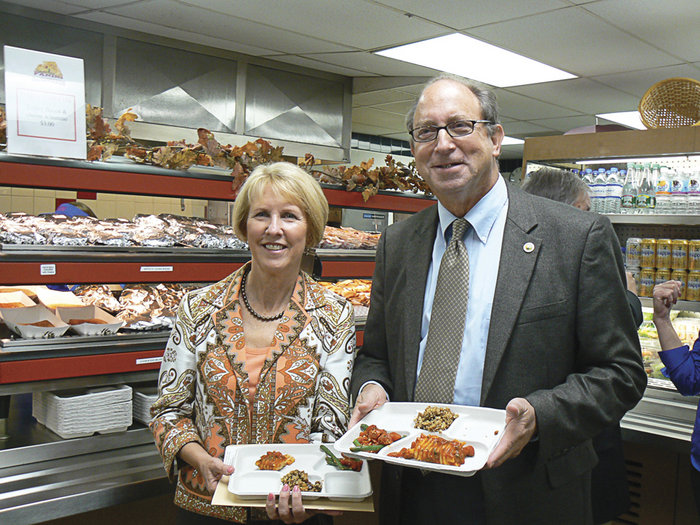State Secretary of Agriculture Douglas H. Fisher and Patricia Dombroski from the U.S. Department of Agriculture on Sept. 19 sampled new school lunch menu items at Secaucus High School that meet healthier federal guidelines. First Lady Michelle Obama announced federal changes in the school lunch requirements earlier this year.
The healthier meal requirements are a key component of the Healthy, Hunger-Free Kids Act, which was championed by the First Lady as part of her Let’s Move! campaign and signed into law by President Barack Obama.
Mayor Michael Gonnelli, local officials, Board of Education trustees, administrators, and students also dined while the state officials were there.
“There certainly is a lot of interest today in the healthy choices kids can make in school,” said Fisher prior to the tasting. “We want our kids to be able to eat better, have better choices, grow up stronger and healthier and this is one way to be able to do that.” He said it was a far cry from many years ago when many went straight to the TastyKake line.
“If you put pizza there and you put salad there – what do you think a normal teenager is going to do?” – Brianna McCaffery
____________
It is the first time in more than 15 years that the standards have been raised. The new meal requirements reduce salt and fat in addition to requiring more fruits, vegetables, and whole grains. The five components served at lunch include: protein, bread, fruit, vegetable, and milk.
“The school day just got healthier,” said Dombroski, which is the campaign’s slogan. Dombroski serves as the Regional Administrator for the USDA’s Food and Nutrition Service Mid-Atlantic Region.
Dombroski said that changes such as offering low-fat milk and reducing or eliminating soda are science-based from information provided by the Institute for Medicine.
She noted that taste buds are still a factor and that they are trying to be very creative to introduce new foods. Some schools are doing taste testing to give students options, in conjunction with learning about where food comes from.
“The pizza now will be whole grain in terms of the curst and a lower fat cheese.” – Michael Gonnelli
____________
“I’m a frequent flyer here,” said Mayor Michael Gonnelli. “Unfortunately, I usually get a slice of pizza. I look forward to the whole grain pizza.” He said he looked forward to the foods and hoped they continued to be healthy, nutritious, and enjoyable to the students.
“A healthy student is a happy student,” noted John “Jack” McStowe, school board president.
Healthy as a choice
Fisher, Dombroski, and Mayor Michael Gonnelli as well as local officials, administrators, staff, and board trustees were served small portions of whole grain lasagna rolette, green beans Roma, garlic sticks, and baked apple crisp. Other menu options included grilled chicken pasta primavera, cannellini bean salad, chilled green bean salad, a hummus and vegetable platter, and a fruit and cheese platter.
The meals were prepared by food service provider Maschio’s. President Frank Maschio and Regional Supervisor Chris Traks took the group through the lunch line and Corporate Chef Steve Escobedo served up the meals. Maschio held up the “swap out” options that included the hummus and vegetable platter and fruit and cheese platter. Last June the Secaucus school board renewed the contract for Maschio’s after discussing changes to expand the menu choice and improve the presentation of the food in response to parent and student requests. Escobedo, who came on four months ago, said that it was a challenge to reduce the fat content. He said his goal in creating the menu is for the food to be “great tasting,” and “appealing.” Escobedo said that Maschio’s introduced 75 new recipes for the school year and also attempts to get locally-sourced produce.
Next week, the state celebrates Farm to School week that emphasizes working with local and regional farmers.
“The hope is that with improved diet we will be able to tackle the obesity problem,” said Dombroski. She noted that New Jersey is one of only three states where school meals are administered at the state level through the Department of Agriculture.
“New Jersey is unique because it allows that real connection of agriculture and farm to food meals,” said Dombroski.
Pasta, portions and price
Outside the lunchline, students took the opportunity to speak with Fisher and shared their thoughts on the food.
“Pasta Tuesdays were the best,” said senior Brianna McCaffery to Fisher.
“Mostly the sandwich line is packed,” said senior Kenneth Mercado.
“I didn’t even know we had hummus, said McCaffery.
“People always go to the easiest and fastest,” Fisher told the two seniors. “They have to train themselves to sometimes think, ‘Wait a minute — this is not the best choice.’ ”
When later asked what it would take to get their peers to eat healthier meals, the seniors both said it came down to a matter of personal choice.
“You have to want it,” said McCaffery.
“You can’t really force healthy foods on kids and expect them to eat it,” said Mercado. Mercado shared that he often brought his lunch, and that while there is a wide variety of choices, lunch is too expensive.
“If you put pizza there and you put salad there – what do you think a normal teenager is going to do?” said McCaffery.
A scan of the cafeteria revealed that some kids did choose pizza, but others had salad. Sophomore Joshua DeJesus was one of the teenagers who went for the salad.
“Pretty good,” he said about the food. “There is a good selection.” He said that he often ate a salad or a sandwich because he is an athlete and plays sports. At 6’1, his only complaint was that the portions are too small and that he ends up buying more food as a result.
Adriana Rambay Fernández may be reached at afernandez@hudsonreporter.com.
